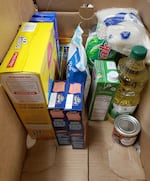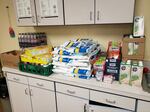
Meat and dairy products are added to a food box to support a family of four, at Agape House in Hermiston, Ore., Nov. 12, 2021. The charity is facing difficulties in acquiring some crucial things such as Campbell’s Soup, due to supply chain delays.
Courtesy of Agape House
In 2019, Oregon Food Bank served 856,000 people. In 2020, they served 1.7 million.
Ashley Mumm, a spokesperson for the Oregon Food Bank, said that two years into the pandemic, the food bank staff are no longer worried about the “how” of doing what they do.
“Things have somewhat stabilized. In the beginning, when the pandemic first hit, it was bananas. Many people had never used SNAP or a food assistance site before. There was a lot of confusion and fear, which is normal,” Mumm said.
But even as handling an influx of people seeking food assistance has settled, another issue is shaking some Oregon food banks: the supply chain. Across the country, supply chain snags are causing shortages in food. In Oregon, similar issues are emerging, but the effects can vary in different parts of the state.
Mumm said the Oregon Food Bank is being affected by the supply chain disruptions in the food and manufacturing industries.
“We’re having to pay more for a particular type of food. Some crops are not even being picked because of labor shortages. The things to hold the food in are having trouble being produced. So it’s a lot of cascading things all at once,” Mumm said.
Despite the challenges, the Oregon Food Bank continues to distribute over a million pounds of food each week.
Food banks in rural areas are also feeling the effects of increased demand and supply chain issues.
Before the pandemic, Agape House, a food bank in Hermiston, Oregon, served around 400 families a month. They now serve more than 600 families a month, according to Mark Gomolski, executive director of Agape House. One outreach program run by Agape House partners with school systems in Echo and Umatilla to provide elementary school students with a weekend meal pack.

Typical food given to those seeking support at Agape House in Hermiston, Ore., Nov. 12, 2021. The charity is facing difficulties in acquiring some crucial things such as Campbell’s Soup, due to supply chain delays.
Courtesy of Agape House
“For some students in our system, the meals they have at school may be the only meals they get all day,” Gomolski said, “but supply chain hiccups make it hard to get the food we need to support those programs.”
Before COVID-19, the weekend meal pack program served 100 students a week, and they are now struggling to provide for more than 250 students a week.
Gomolski said he is currently on a six-week delay for cans of soup, which are in particularly high demand.
“Right now we need chicken noodle soup, ramen noodles, peanut butter, granola bars, instant packages of oatmeal, juice, boxes of raisins, crackers that have cheese or peanut butter in between them, and cans of tuna,” he said.

Typical food given to those seeking support at Agape House in Hermiston, Ore., Nov. 12, 2021. The charity is facing difficulties in acquiring some crucial things such as Campbell’s Soup, due to supply chain delays.
Courtesy of Agape House
Depending on their location, food banks face different concerns.
Niki Sampson, executive director at Klamath Lake County Food Bank, said the issues she sees aren’t related to more people coming to the food bank.
“The issue at hand is more for those who don’t qualify for SNAP benefits. Those who sit right there on the fence. Those who don’t qualify, but who still need a little help,” she said.
Weather is another worry for Sampson, who said the coming winter and rising fuel costs affect people’s food budgets. Gas prices in particular are a major concern. According to Sampson, people travel anywhere from 50-150 miles to get to the food bank to stock up for before winter storms.
Other food banks reported little to no concern going into the winter.
Tom Sutton, the Food Bank Manager at Grant County Food Bank in John Day, said numbers of families served have decreased over the past year. According to Sutton, in January Grant County Food Bank was serving 151 families, but by September that number was 97, and in October they served 114. He attributed this decline to stimulus checks, increases in SNAP benefits, and unemployment checks helping to buffer the effects of food insecurity in Grant County. But the community’s effort has also made a big difference, according to Sutton.
“The people in Grant County have done a great job supporting our food bank,” he said. “It shocks me sometimes to find out how a little community gives away so much money to volunteer organizations.”.
He expressed a sentiment that was echoed in all of the food banks interviewed for this story: appreciation for volunteers and donors.
Mumm said people who have time or money to spare can help by volunteering, making monetary donations, organizing food drives, or helping to get the word out about Oregon Food Banks’ Food Finder App.
The app directs people to 1,400 food assistance sites in Oregon and Washington.
Mumm said participation in local politics and advocacy is also important.
“We’re never going to put ourselves out of business,” she said, “until we put legislation and policies in place that can help end things like poverty.”
